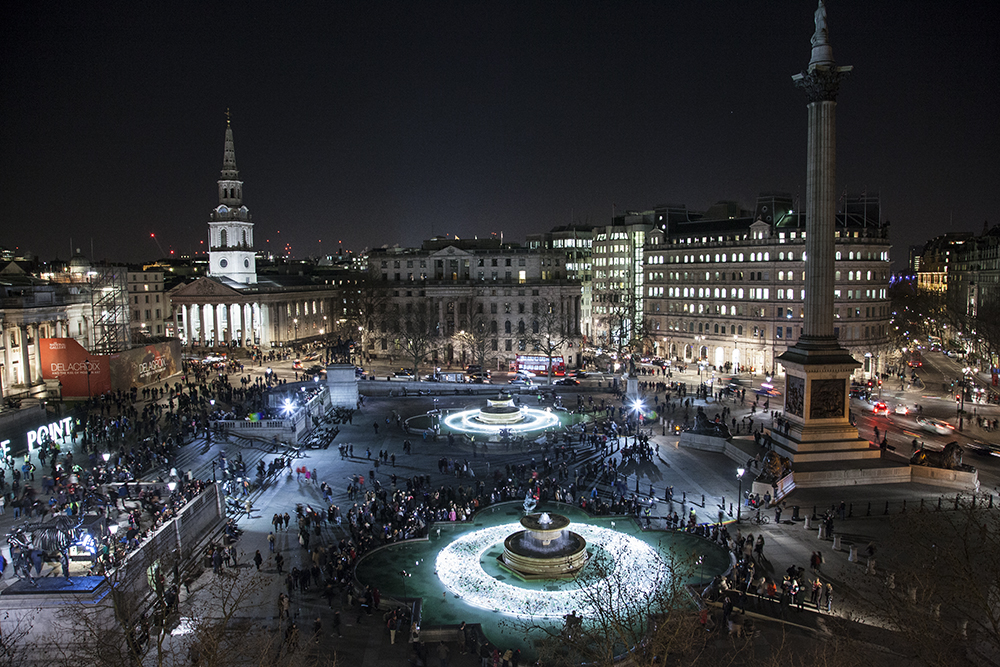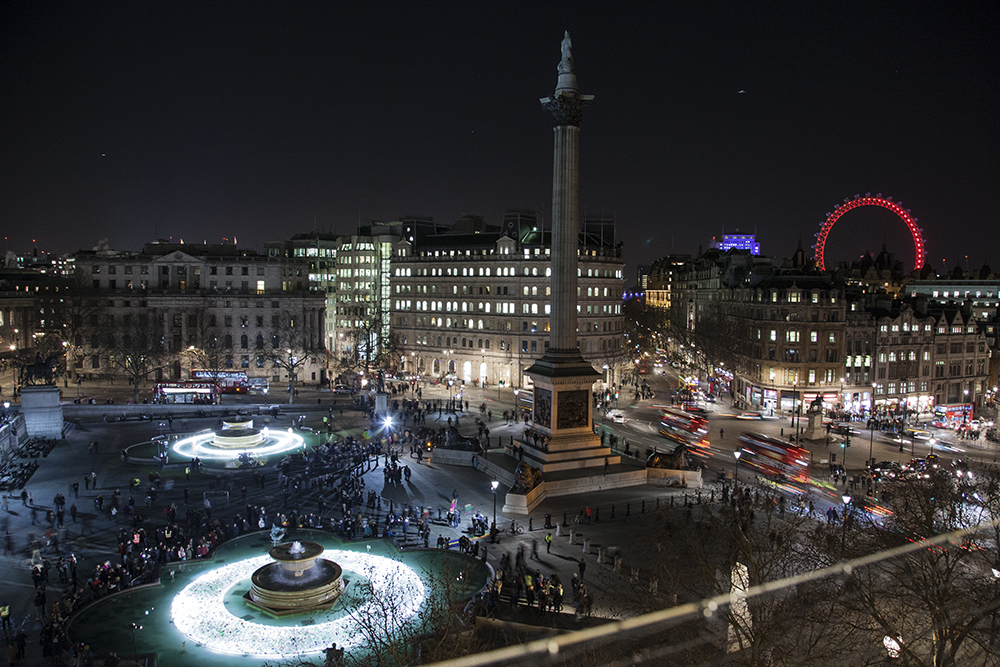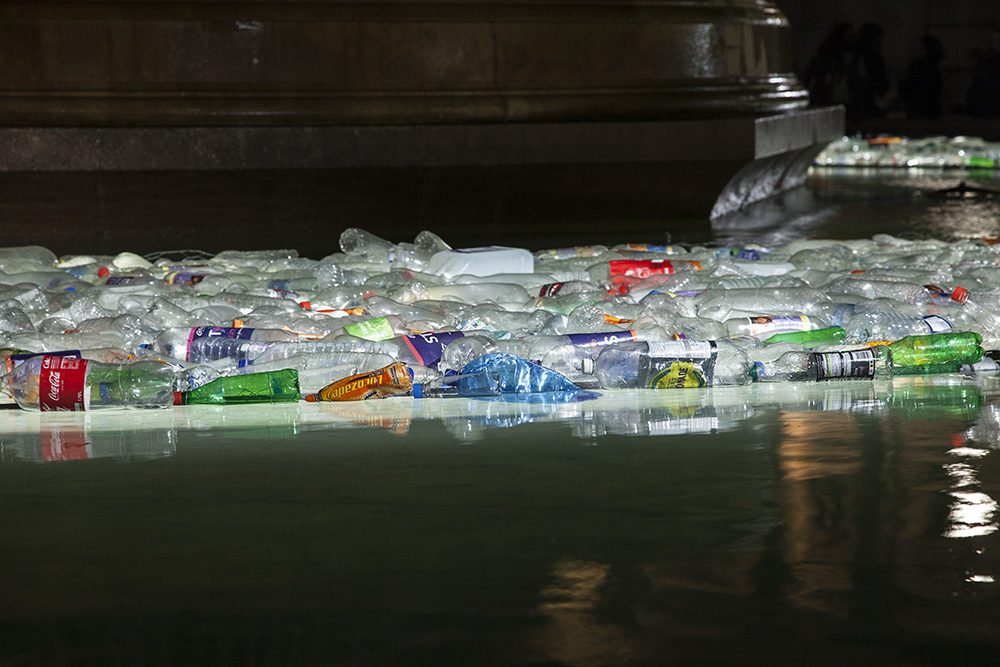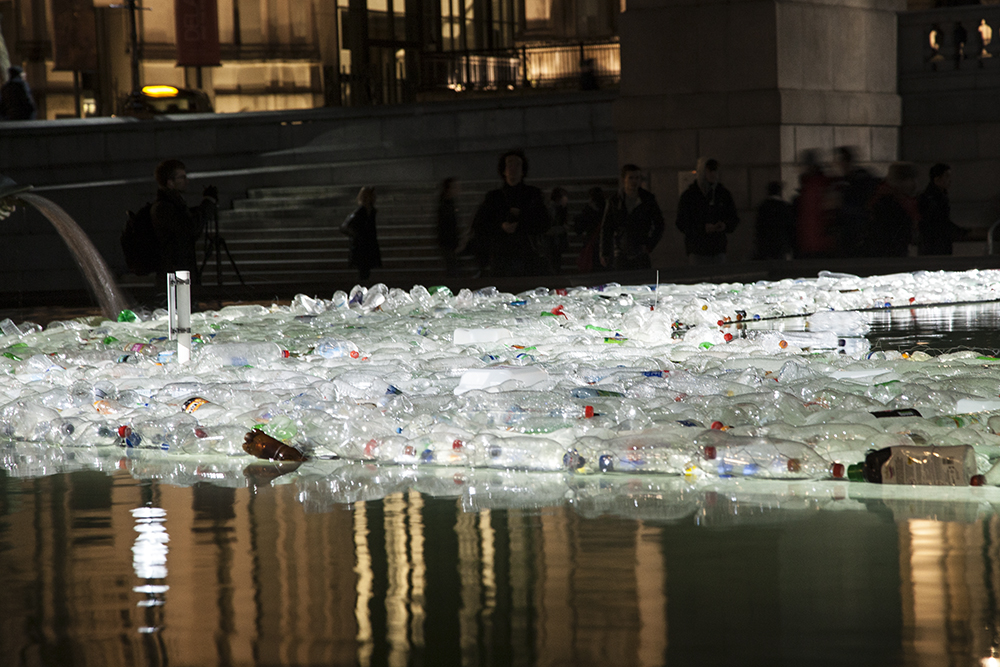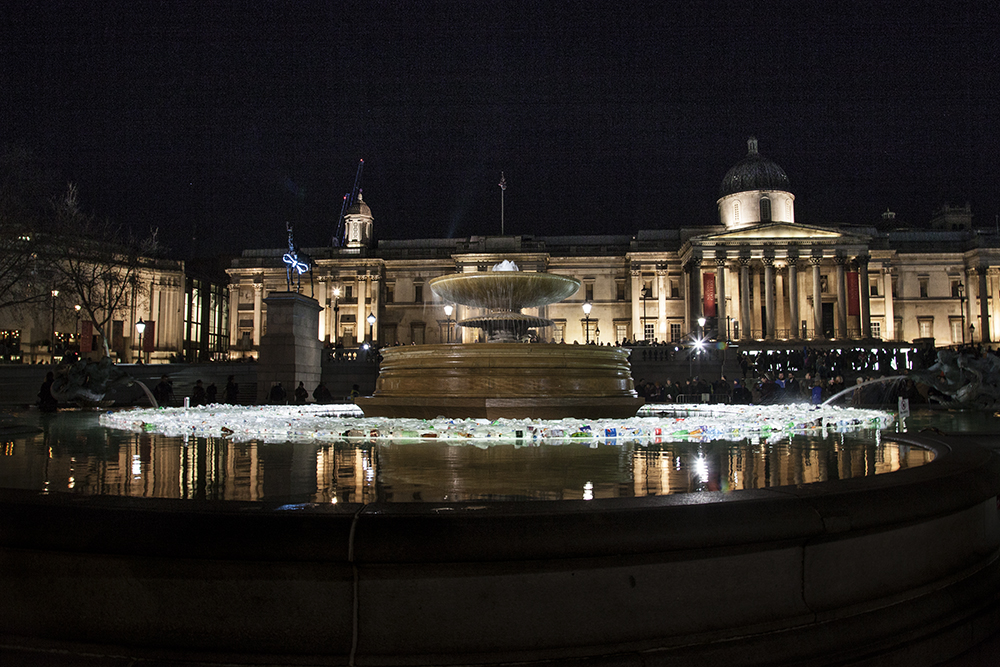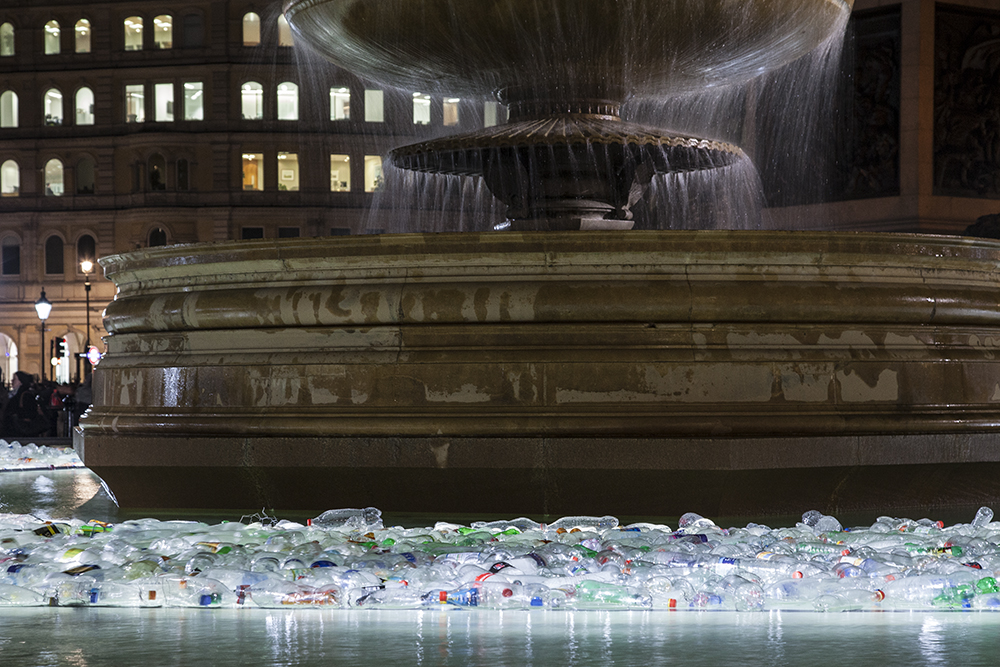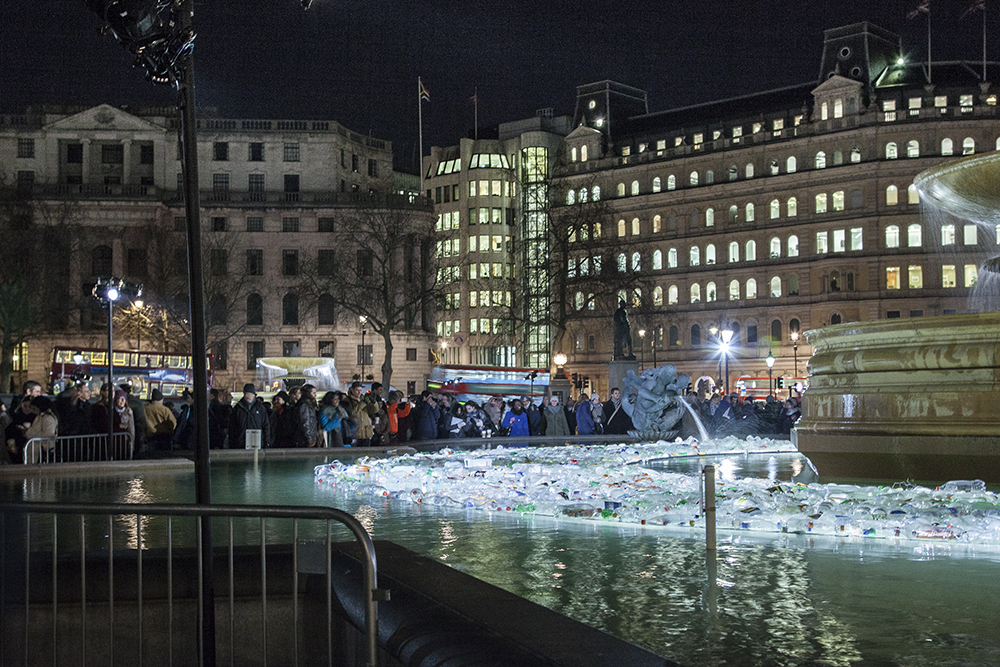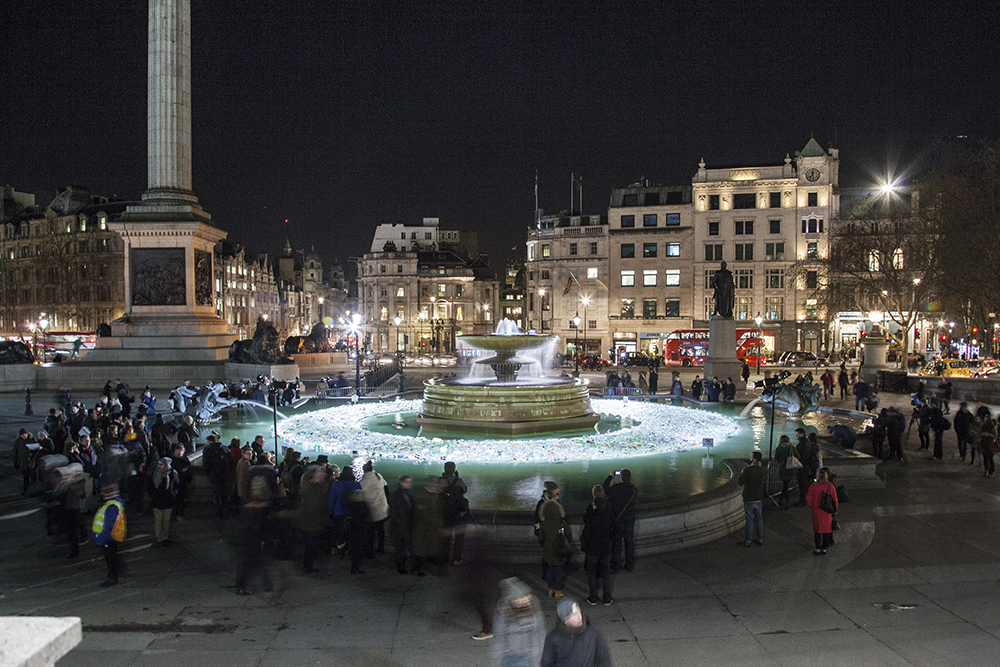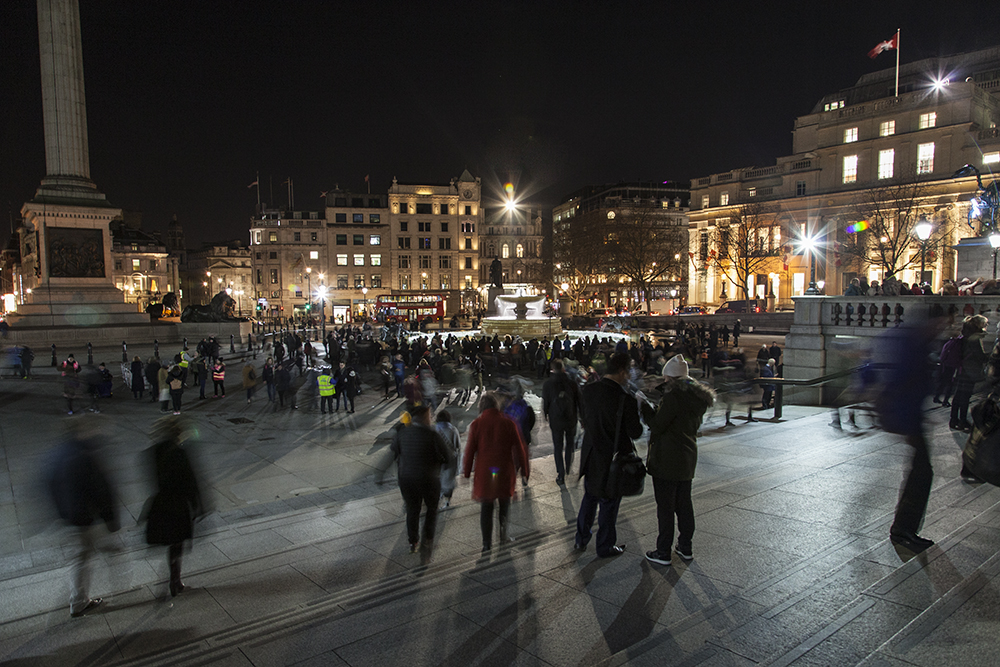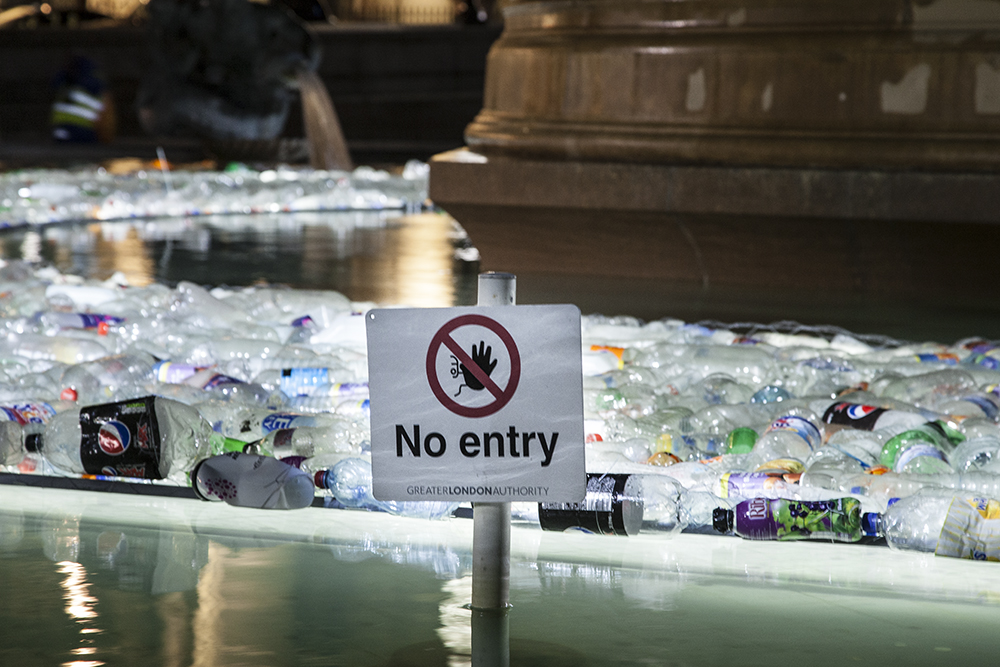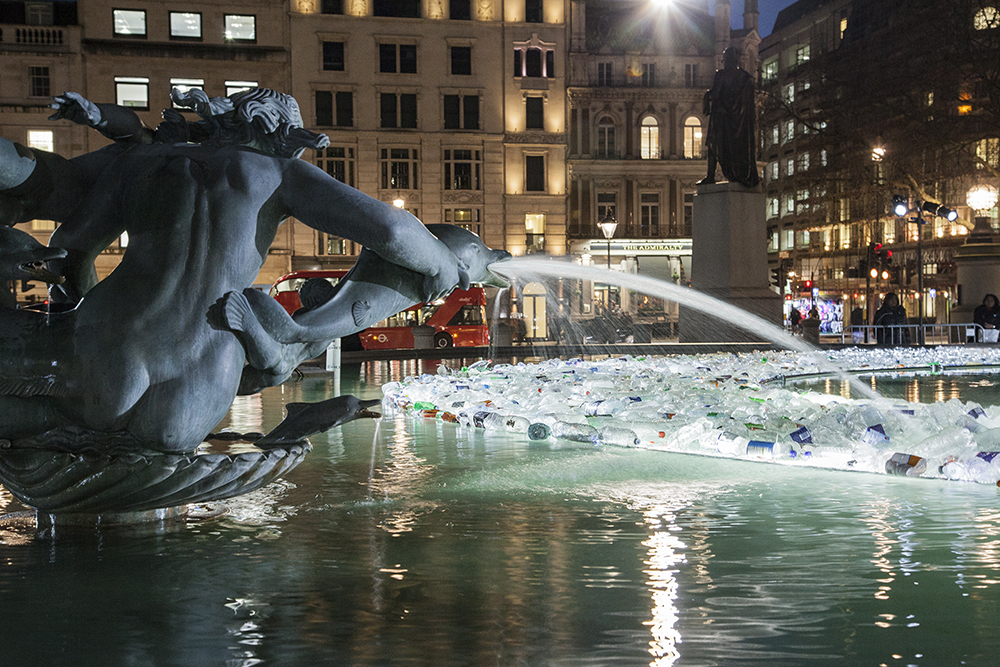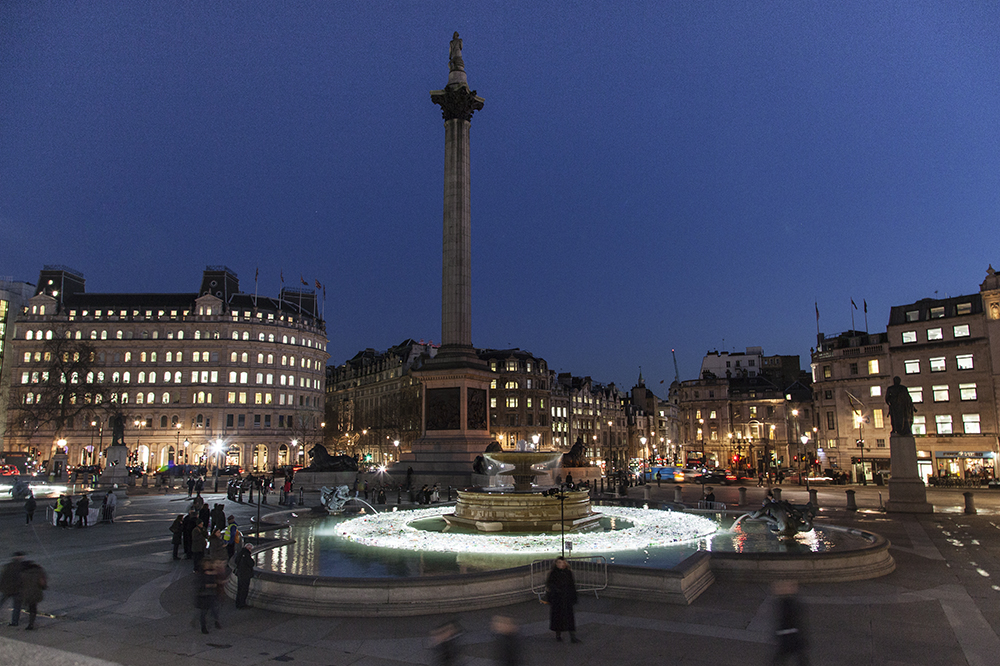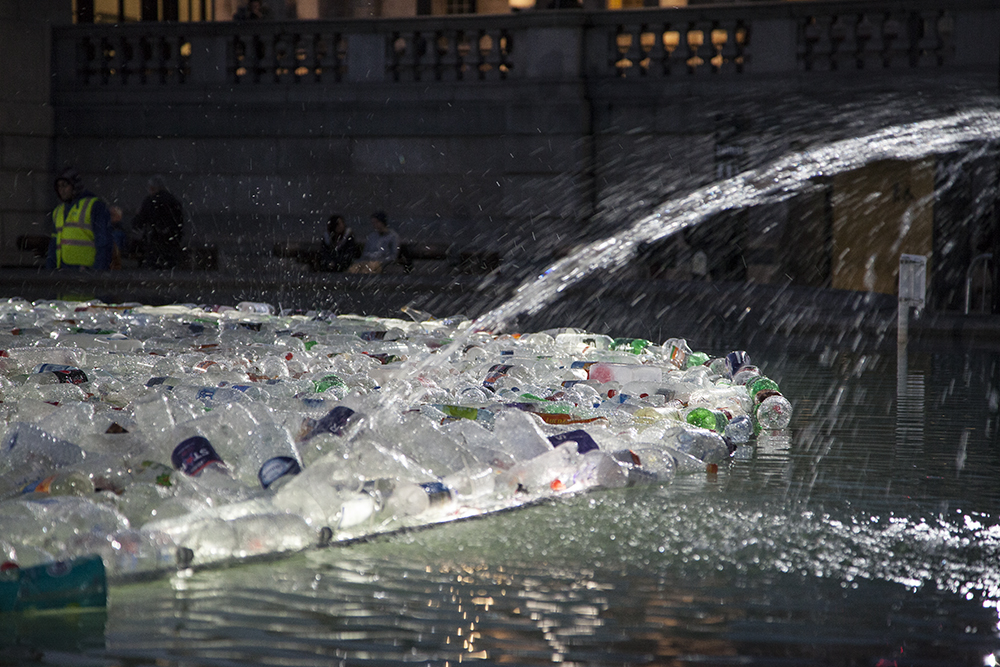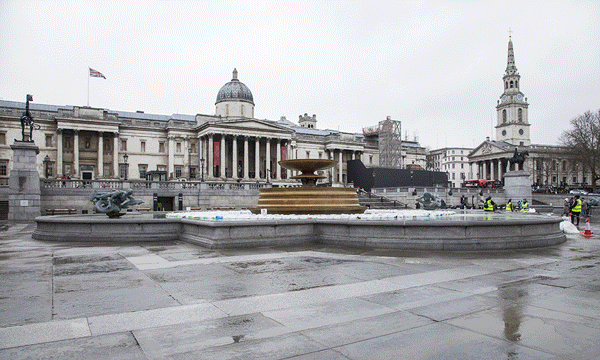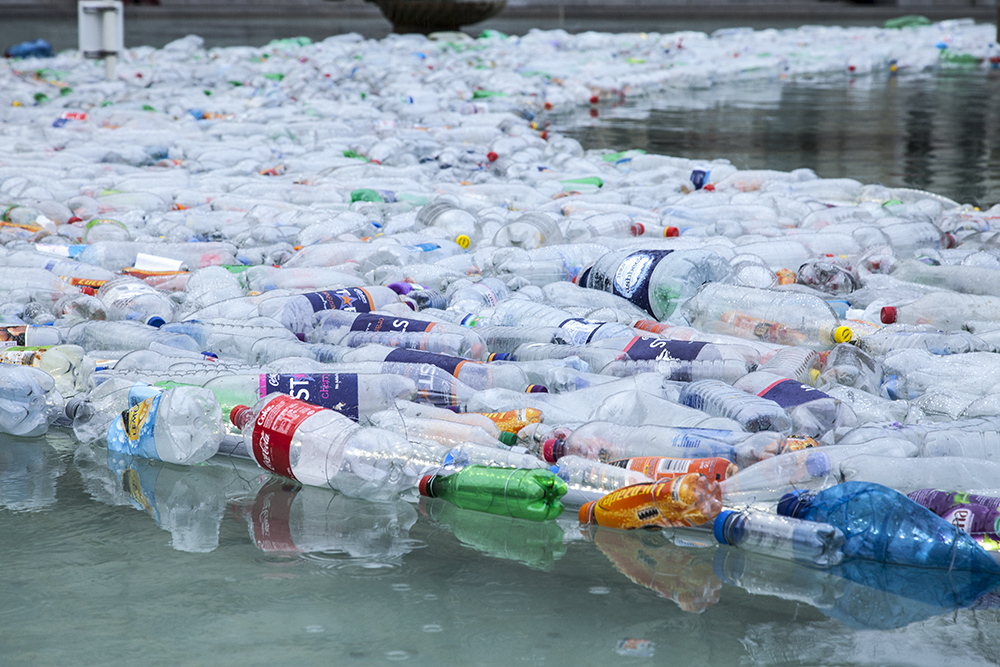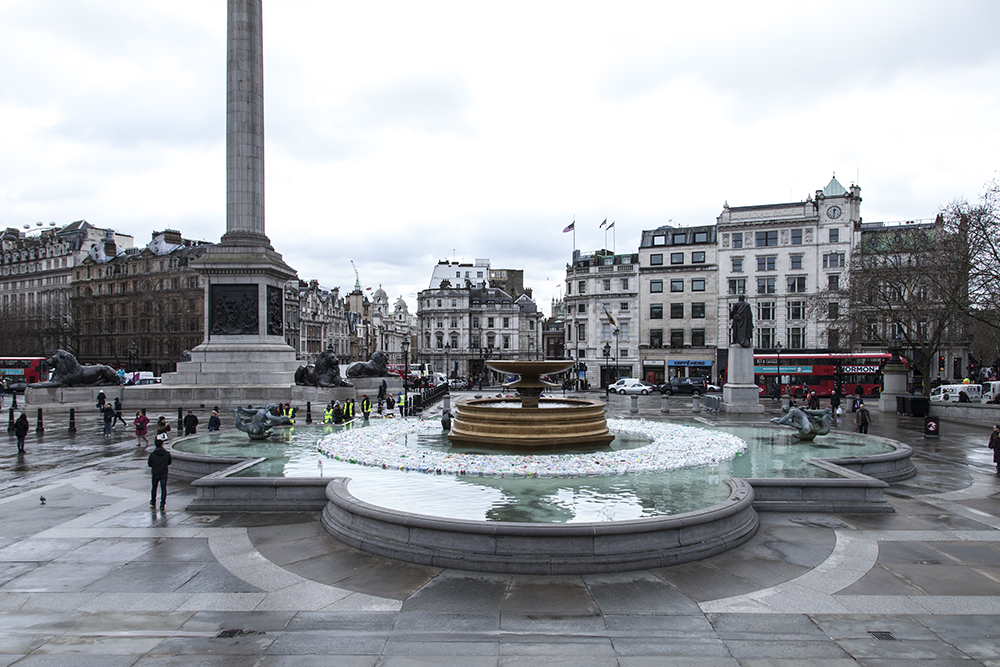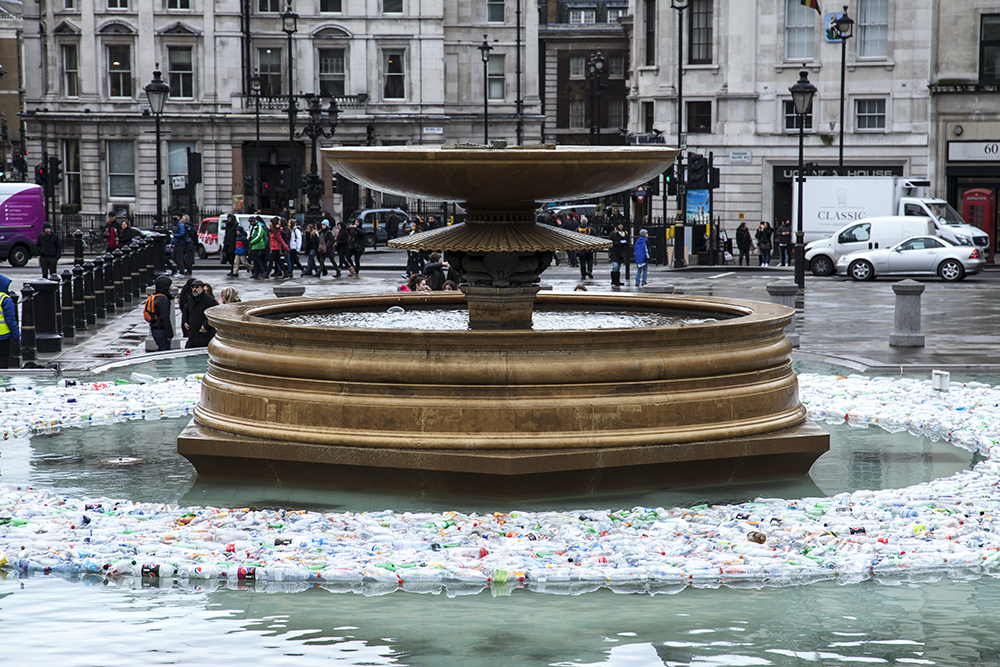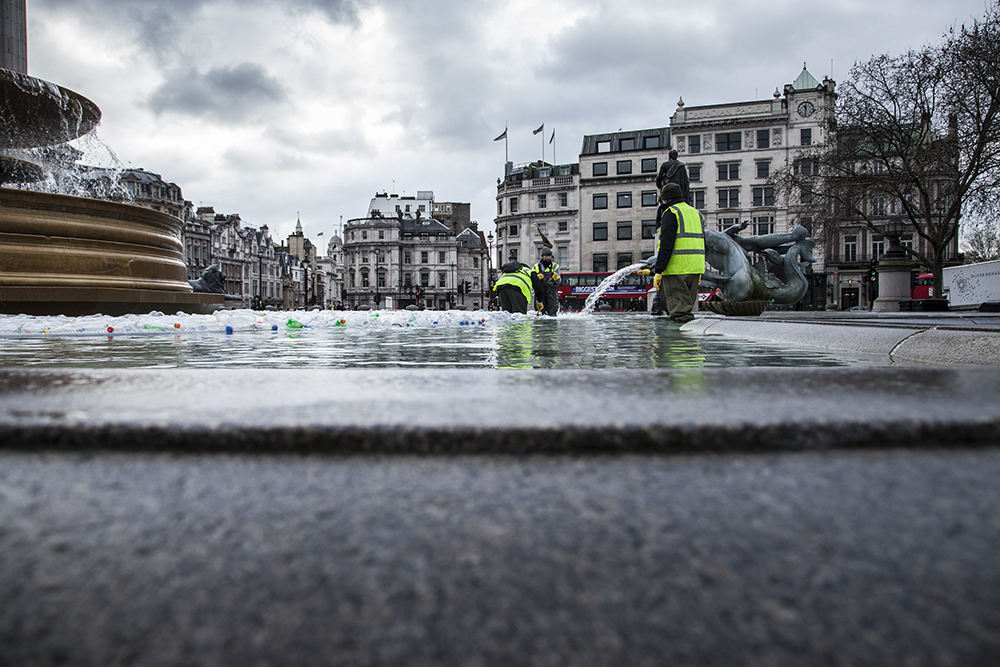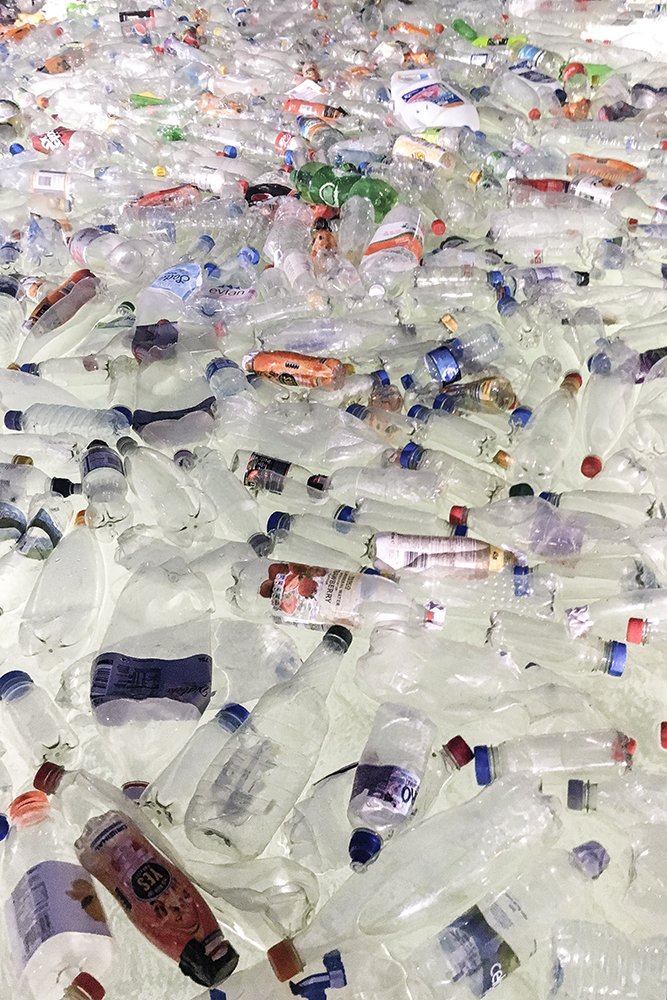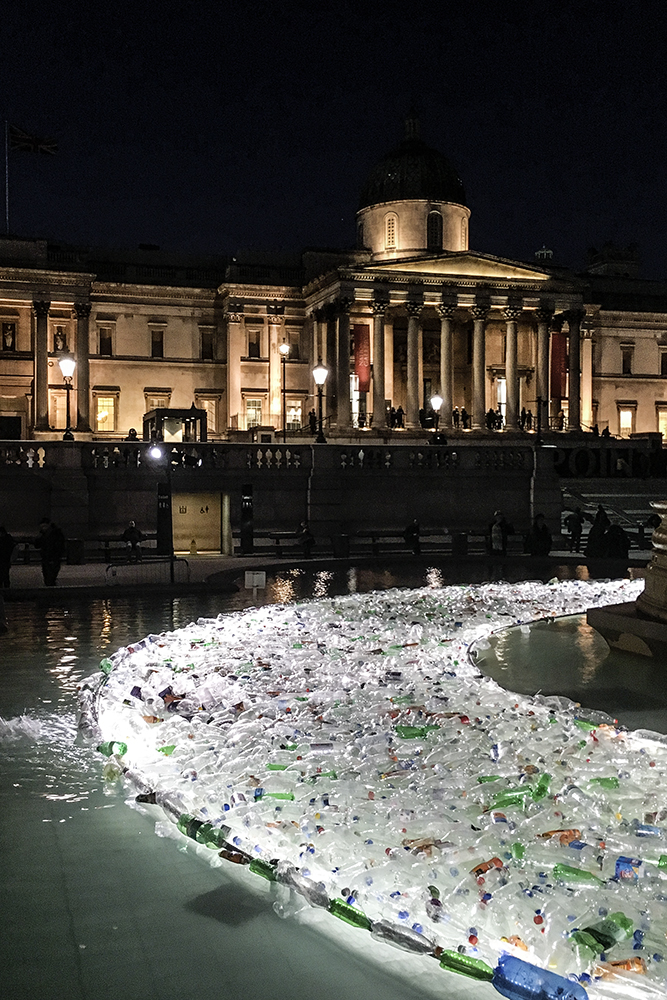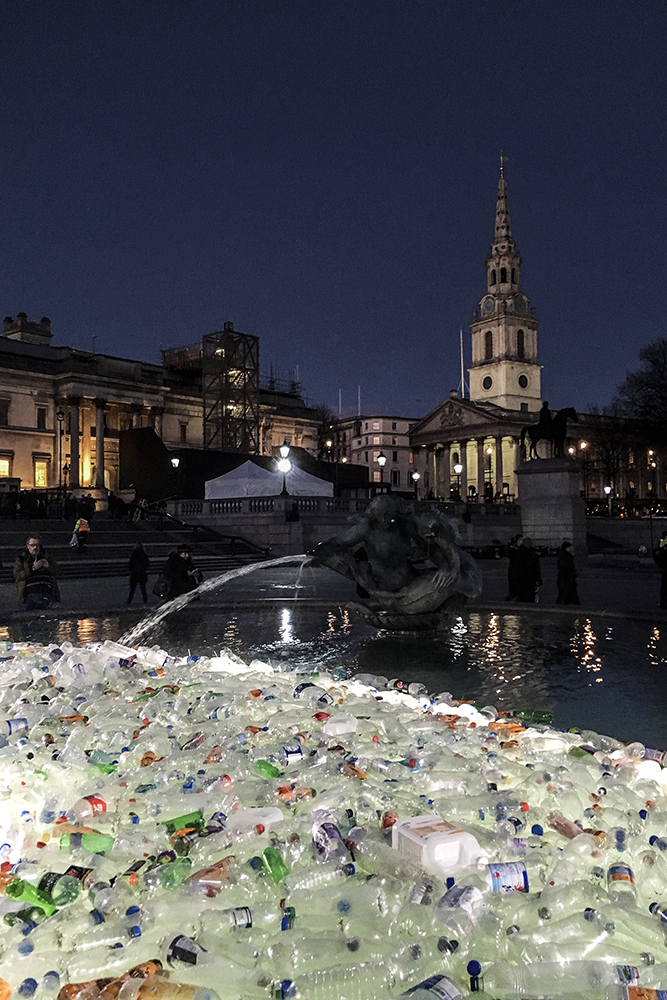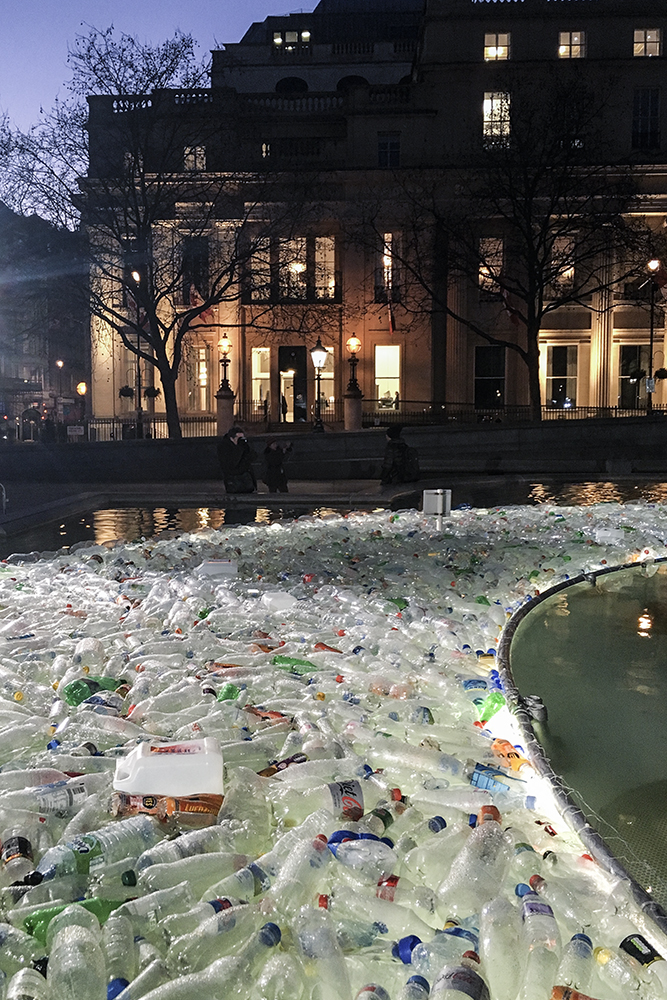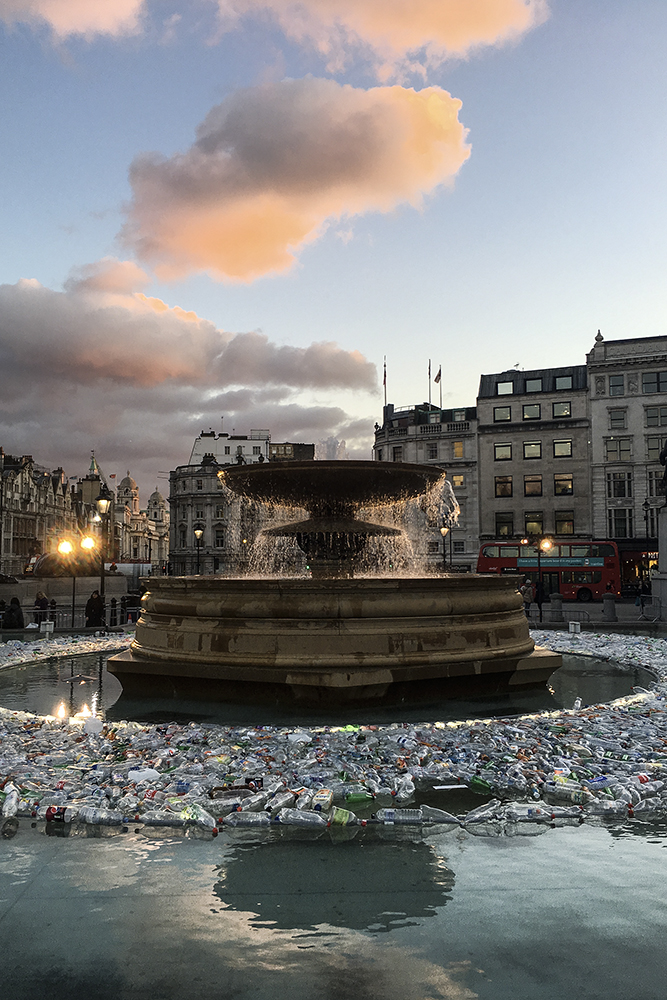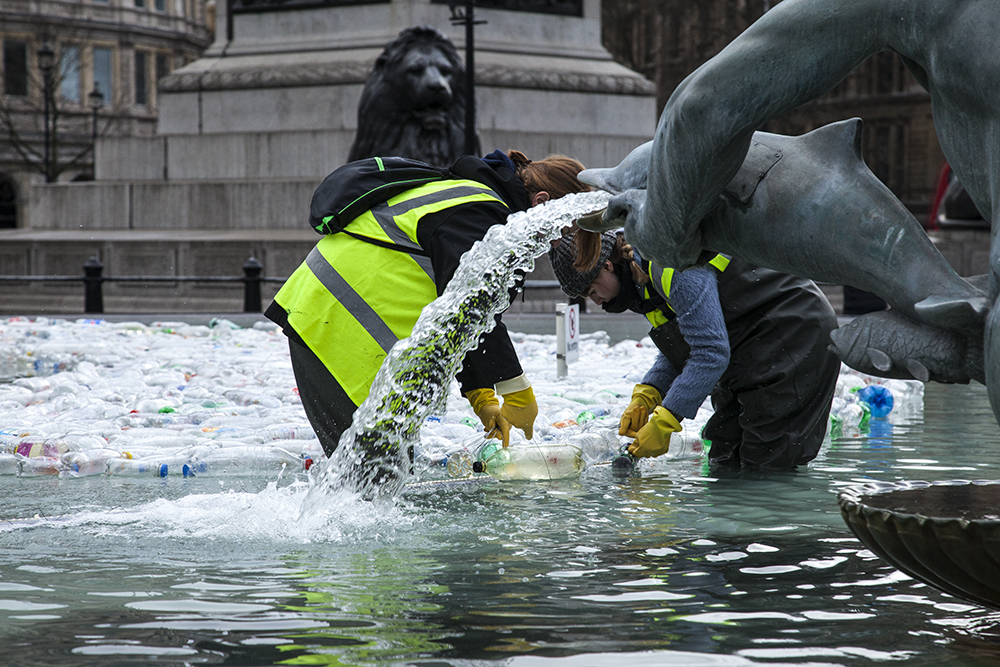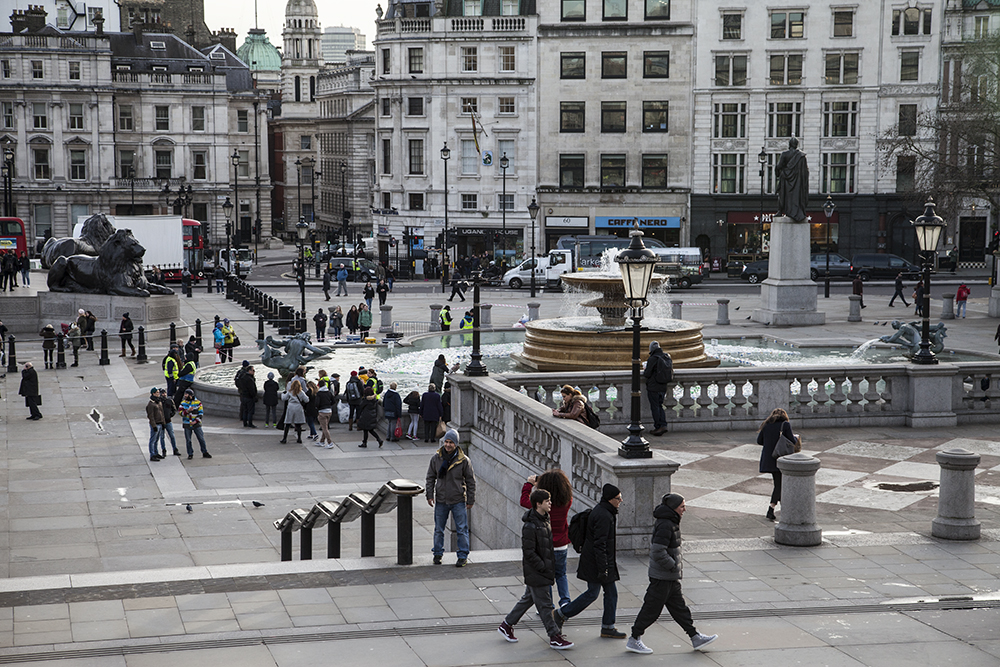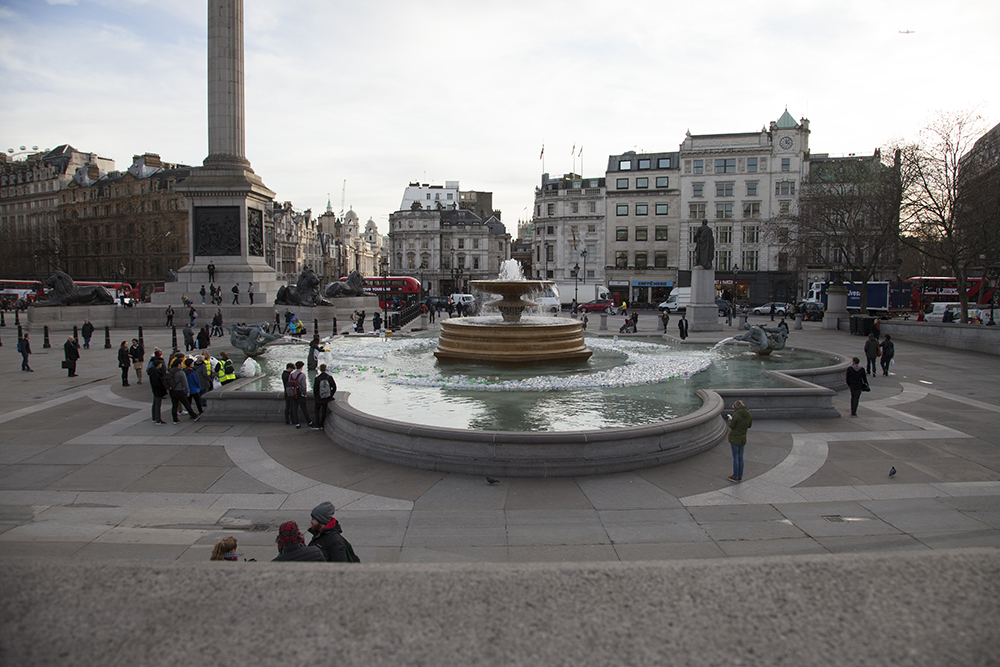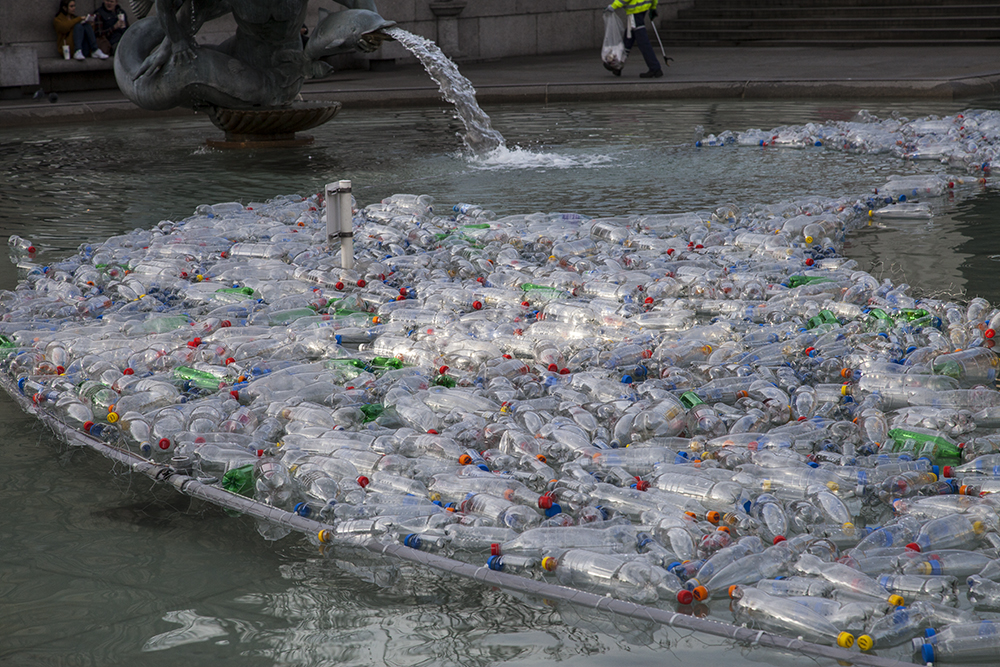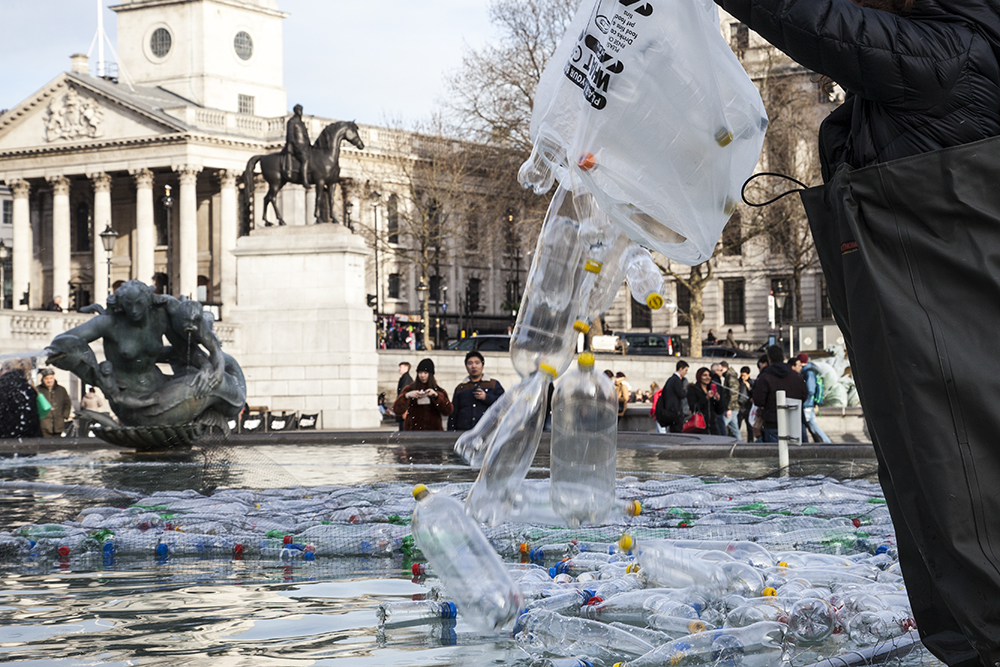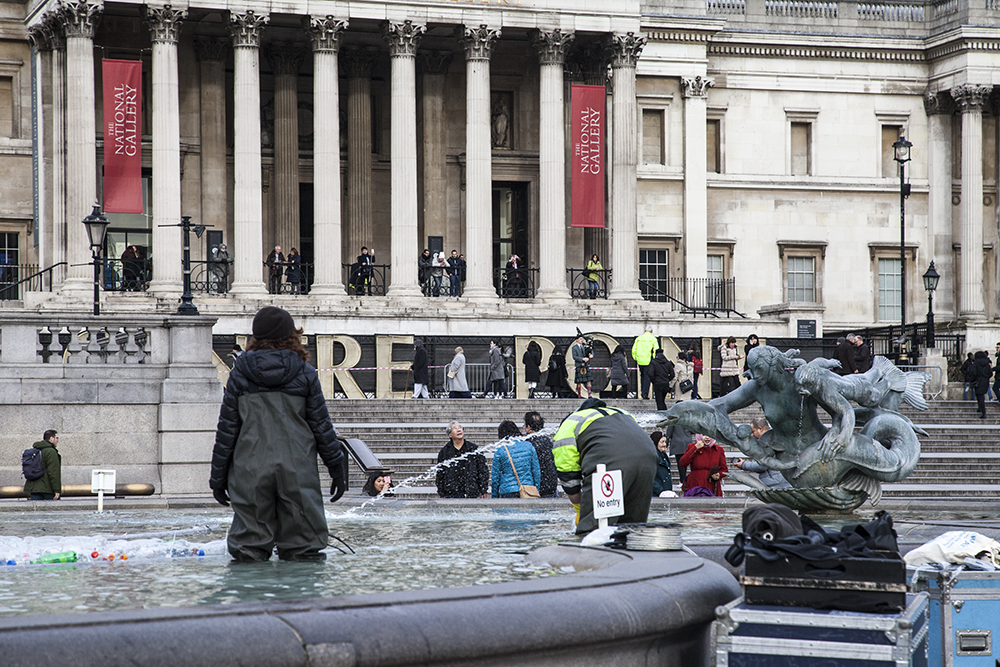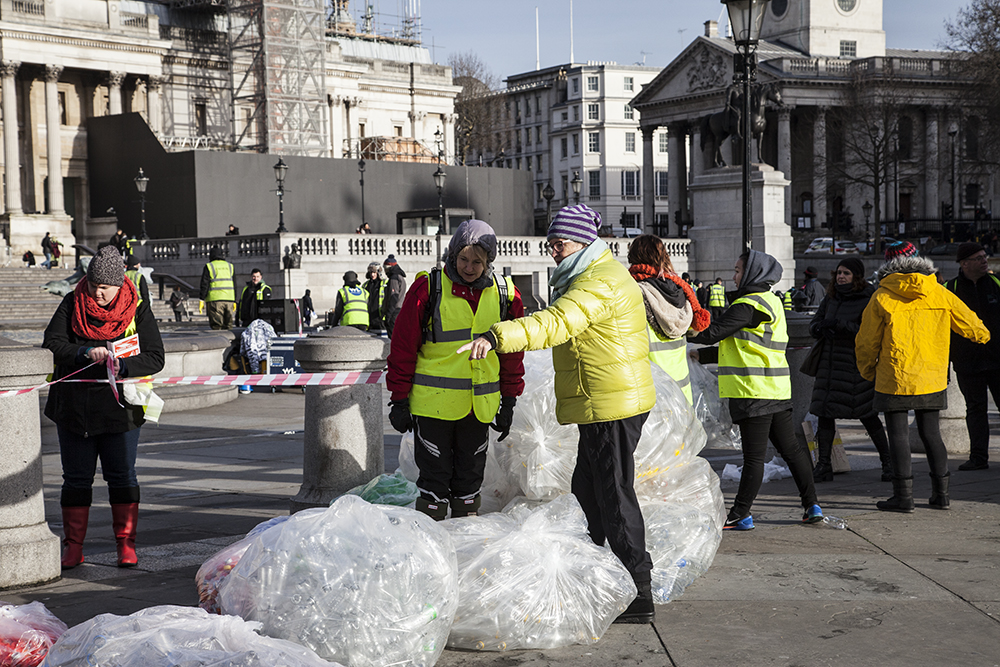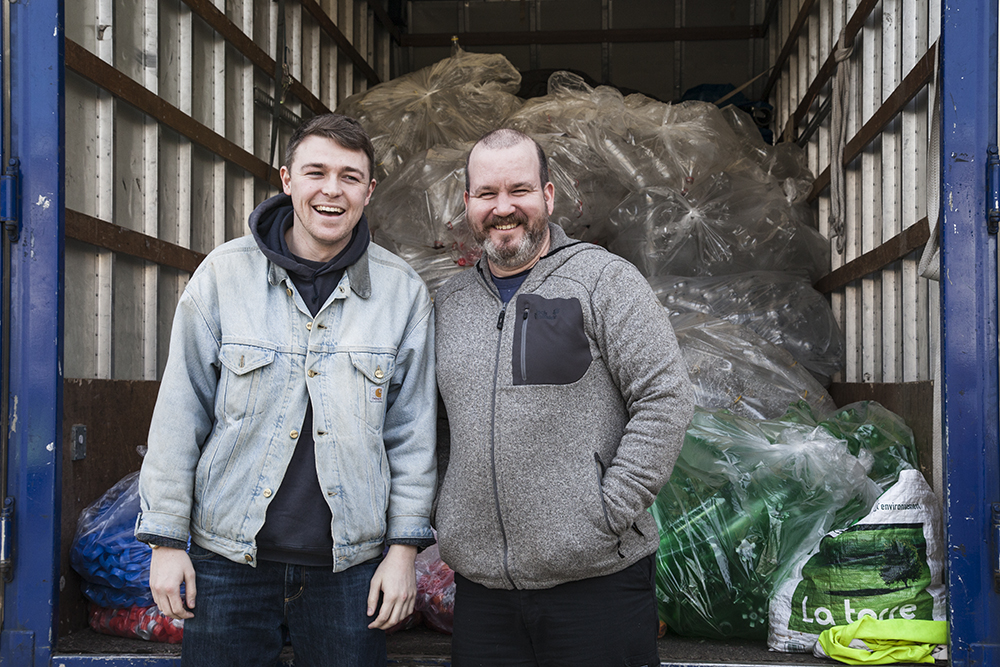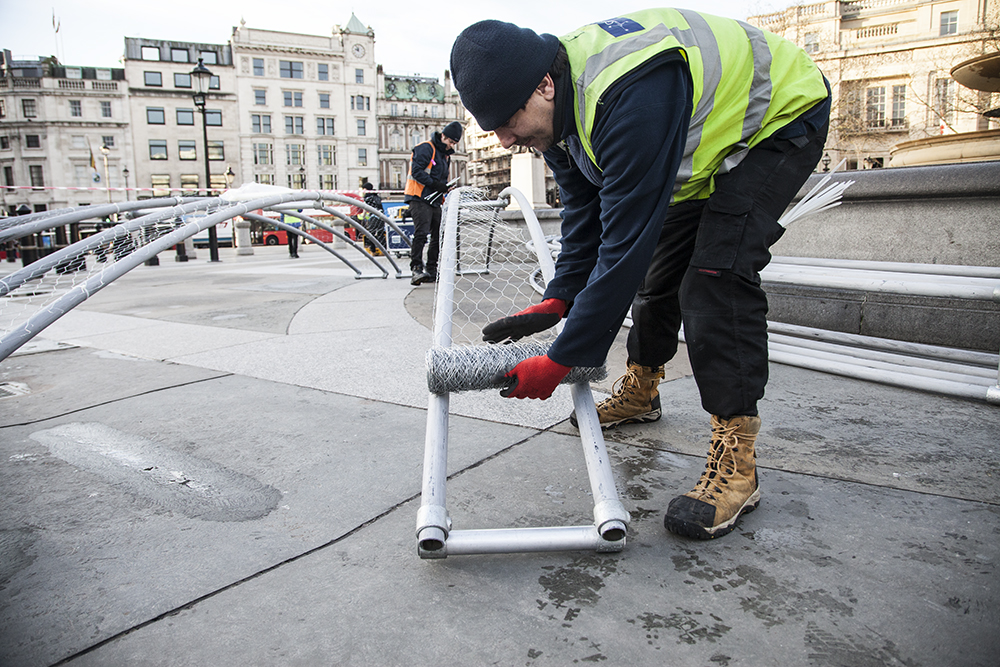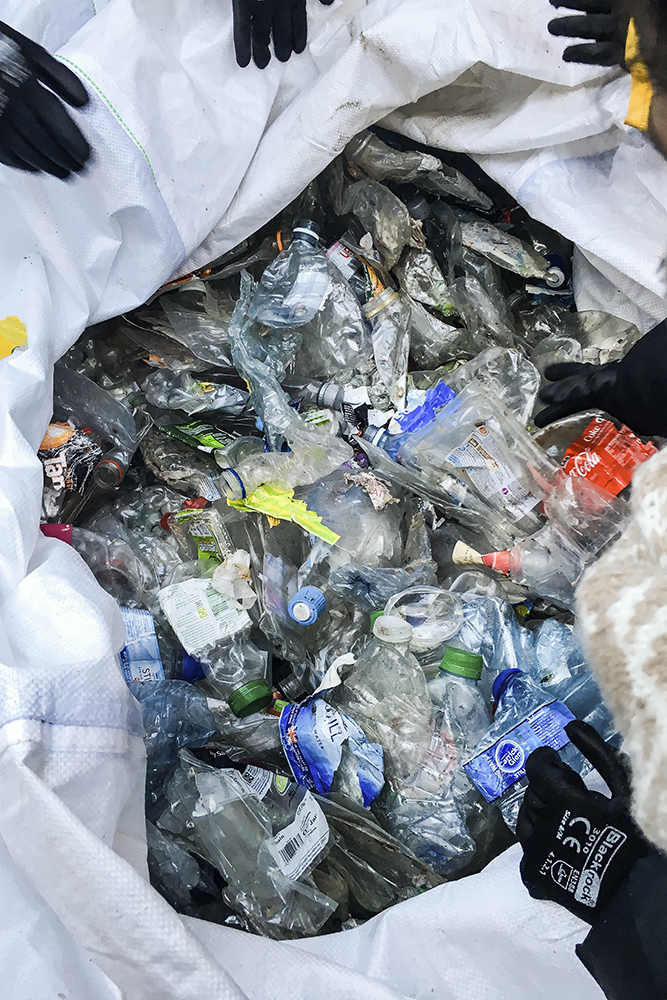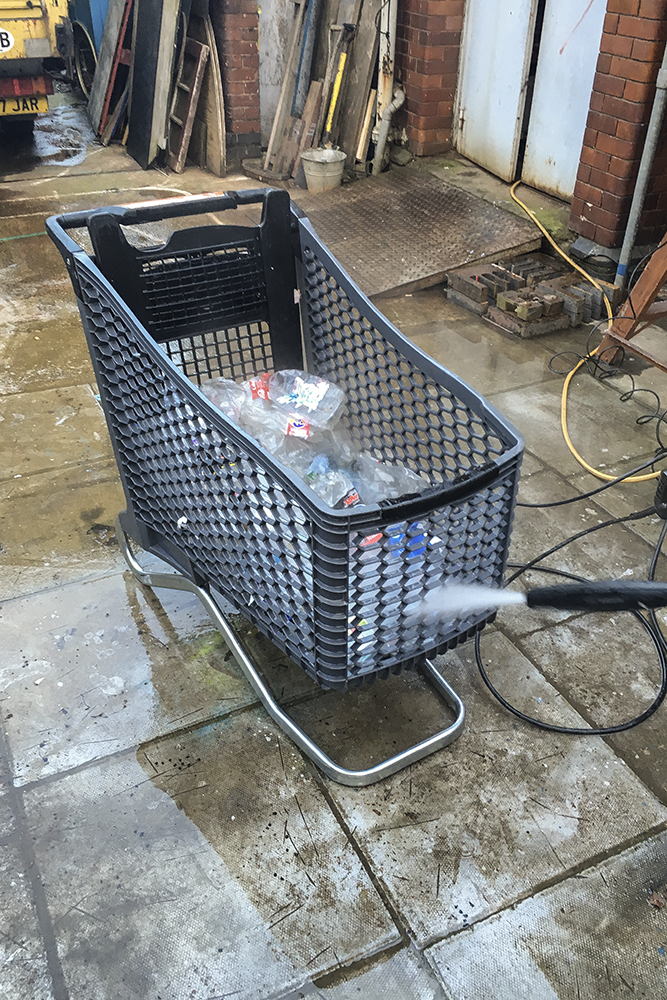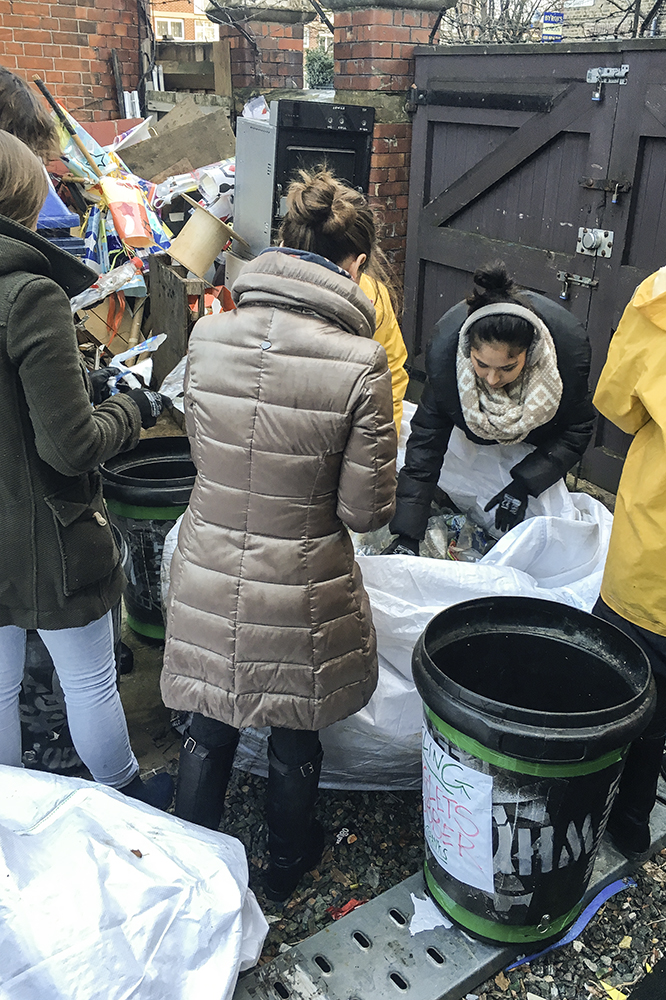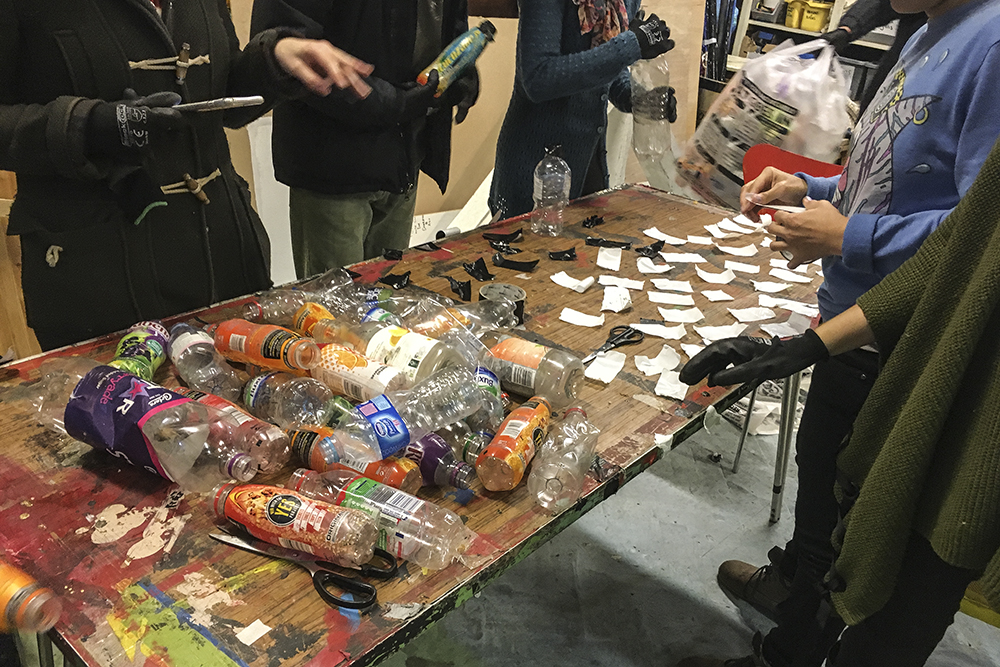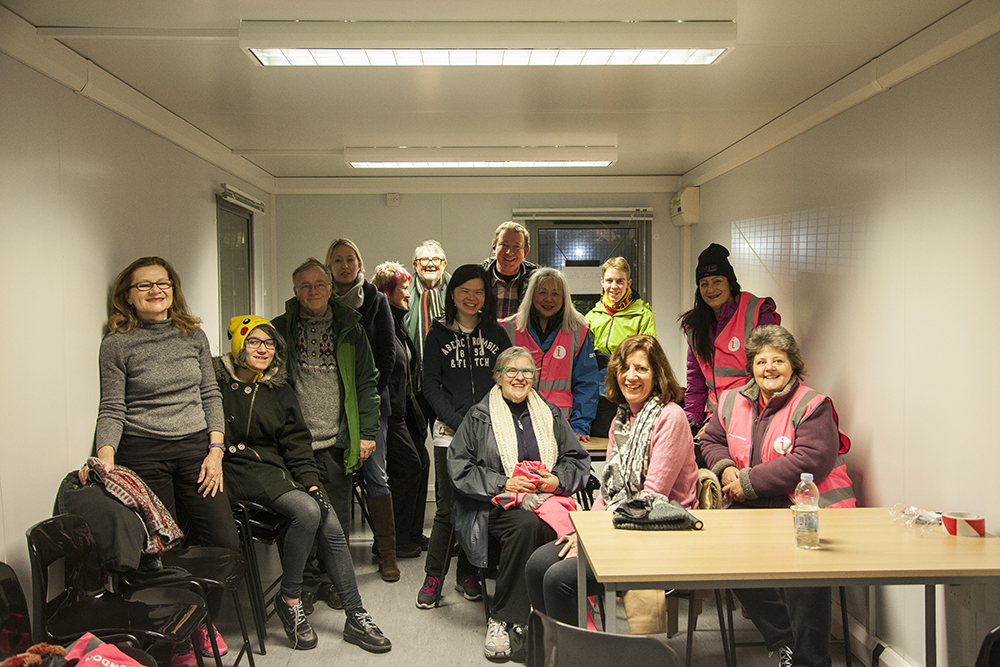Plastic Island in Trafalgar Square / Isla Plástica en Trafalgar Square
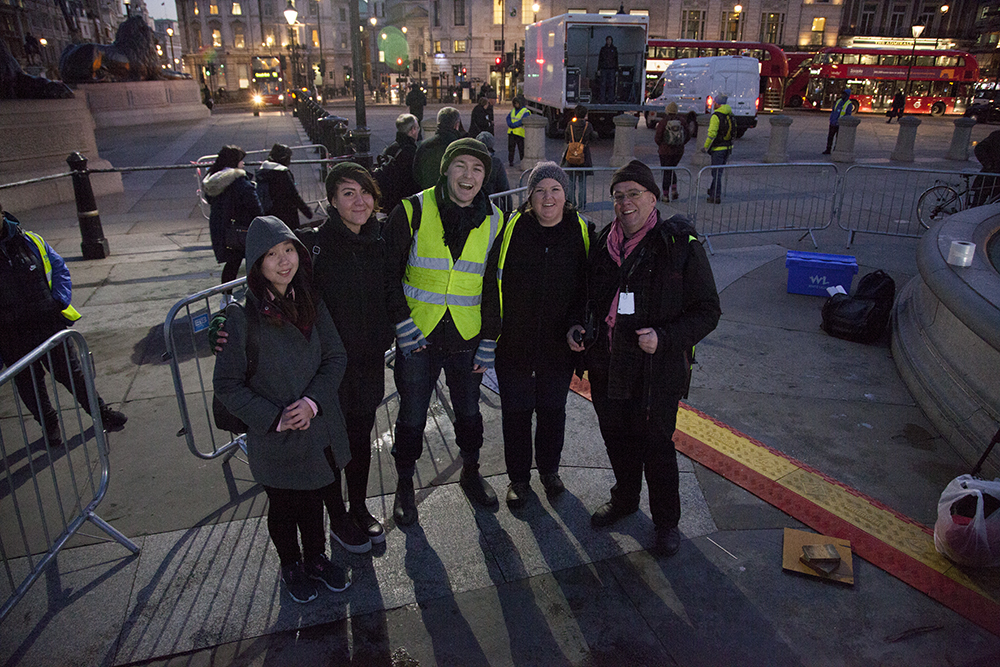
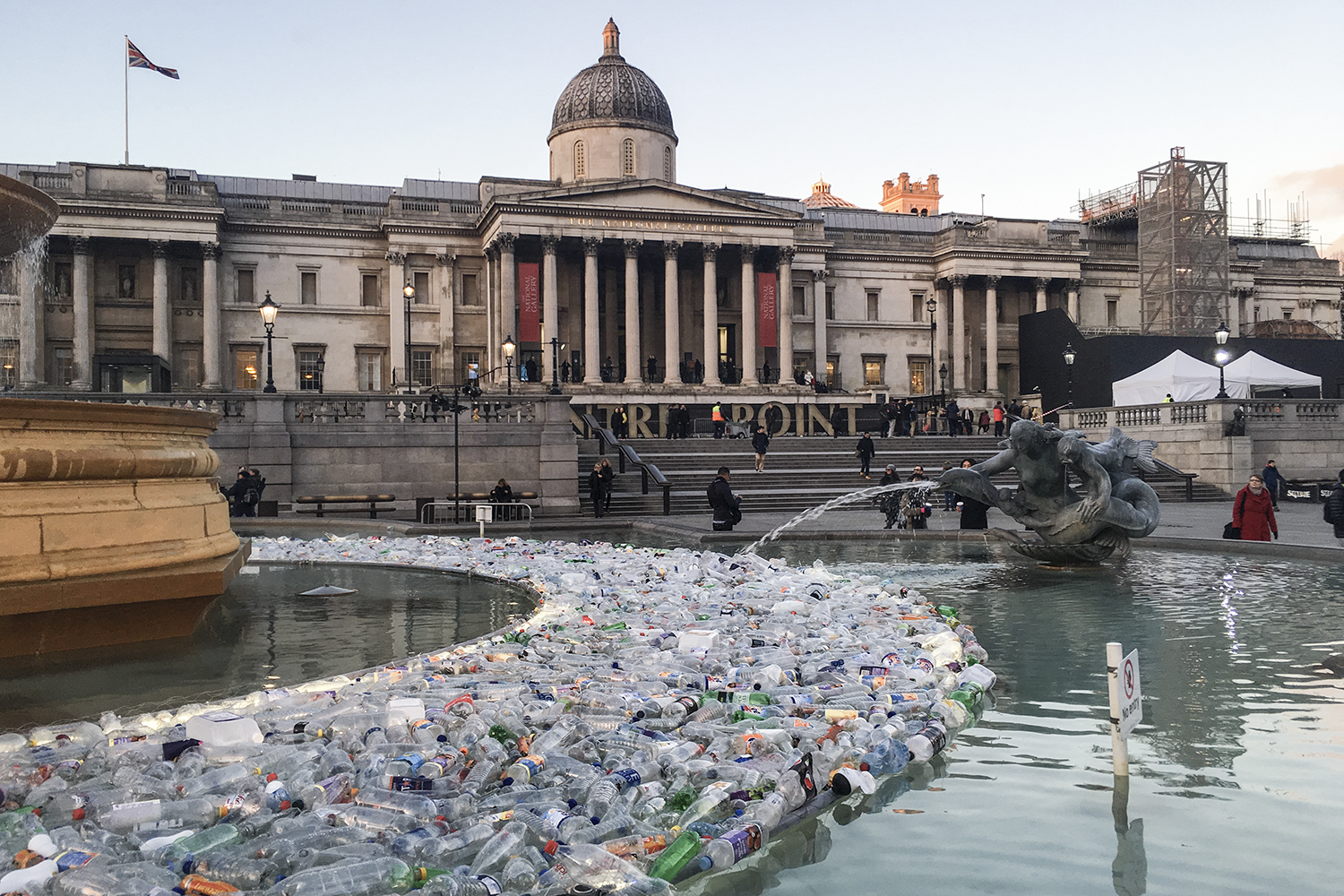
Last January we were invited to the Lumiere London 2016, an unprecedented light festival that offered a unique vision of London during 4 nights getting the public involved massively as they enjoyed a carless, artistically intervened downtown area.
For this edition, they asked us to carry out a new version of our Plastic Island inside the fountains in Trafalgar Square. We could not say ‘No’ to such a challenge. Intervening such an emblematic place would help us to better spread our message on plastic massive usage.
Although this format had to adapt itself to such a complicated space, the piece’s message was still the same: “to replicate, at a smaller scale, the so-called “eighth continent” made of plastic and garbage which is alarmingly taking over great areas of the Pacific. Governments remain passive before this situation either because they lack interest or because they are incapable to solve this problem. They are allowing this huge mass of about 4 million tons of more or less crushed plastic to shape about 22,200 kilometers (about 13,794 miles) of irregular surface which goes 30 meters (about 98 feet) deep under the water, and is destroying most of the marine wildlife in the area and transforming the ecosystem.”. You can read more of this article…
We initially thought about just filling the fountains with recycled bottles and have them illuminated by the monument’s light – this was a quick, cheap solution without technical difficulties but, being such an emblematic space, inevitable technical problems came up so we finally decided to build doughnut-shaped self-illuminated round structures that were to hold the bottles inside, making them inaccessible to the public.
They got us 13,000 recycled plastic bottles, many of which had to be thoroughly cleaned as they had been retrieved from trash containers. We also had to put the cap on them so they could float. We were able to fill the first fountain with all this material.
For the second one, we asked visitors to give us their bottles. However, we did not get enough bottles so we gave up the idea of filling it, leaving the structure illuminated but empty. We didn’t mind this too much and even found this emptiness appropriate.
This installation stayed at Trafalgar Square from January 14 to January 17, accompanying Hans Haacke’s sculpture which was at Plinto at the time carefully watched by the police, the square’s visitors and, of course, by Lord Nelson. It was dismantled on Sunday the 17th, being all the elements prepared to be re-used or returned to where they came from – the city’s recycling plants.
Our special thanks to Artichoke who counted on us again for this project and, apart from inviting us and producing the piece, also got the recycled material, the volunteers, and obtained the permits to do the installation in such an emblematic place after hurdling all the complicated red tape which, at times, looked like mission impossible. Thanks to Bill and Helen for fighting for the piece to the end.
Thanks to all our dear volunteers who helped us and stayed with us during the entire process: cleaning the bottles, doing the installation in the fountain, the on-site explanations and the dismantling.
Also thanks to the Emergency Exit Arts people from Greeenwich, who hosted us and provided us with all the means necessary to clean and condition the bottles. Many thanks also to the people in charge of the fountains for lending us their gear to get in the fountains without freezing to death.
Many thanks to Lola Martínez for her incredible photos, also to the Canada House for letting us get on their rooftop to photograph our piece, and to Spain Now for their emotional support, which was especially needed while being inside a fountain of freezing water for a long time.
Lastly, we invite you again to watch Charles Moore’s video on this “Eight Plastic Continent”.
Time of installation: 3 days.
Damages: none.
Exhibition time: 4 days.
————————————-
El pasado mes de enero fuimos invitados al Lumiere London 2016, un festival de luz sin precedentes que durante 4 noches ofreció una visión única de Londres, involucrando a un público masivo que pudo darse el gusto de disfrutar del centro urbano, artísticamente intervenido y sin coches.
Para esta edición, nos propusieron llevar a cabo una nueva versión de nuestra Isla Plástica dentro de las fuentes de Trafalgar Square, y claro, no pudimos decir que no a semejante reto. Intervenir en un lugar tan emblemático nos ayudaría a difundir mejor nuestro mensaje sobre el uso masivo del plástico.
Aunque el formato tenía que adaptarse a tan complicado espacio, el mensaje de la pieza seguía siendo el mismo, «recrear, a pequeña escala, ese octavo continente de plástico y basura que va apoderándose alarmantemente de grandes extensiones del Pacífico, ante la distante mirada de los gobiernos que o bien por su falta de interés, o su incapacidad para resolverlo están dejando que una masa de unos 4 millones de toneladas de plástico mas o menos triturado, dé forma a unos 22.200 kilómetros de superficie irregular con una profundidad de treinta metros bajo el mar, que está destruyendo gran parte de la fauna marina de la zona y mutando el ecosistema». Podéis leer más, en este artículo…
En un primer momento, nos propusimos simplemente llenar las fuentes con botellas recicladas e iluminarlas con la propia luz del monumento, algo rápido, barato y sin complicaciones técnicas, pero al ser un espacio tan emblemático, surgieron inevitables problemas logísticos, por lo que finalmente optamos por construir unas estructuras circulares autoiluminada en forma de donut que contuvieran las botellas en su interior, haciéndolas inaccesibles al público.
Nos consiguieron 13.000 botellas de plástico recicladas, muchas de las cuales hubo que limpiar a conciencia, ya que habían sido recuperadas de la basura, también tuvimos que taparlas para que flotaran. Con todo este material pudimos llenar la primera fuente.
Para acometer la segunda, hicimos una convocatoria pública con la idea de que los visitantes, nos cediera sus botellas, pero finalmente no conseguimos todas las que necesitábamos y desistimos de completarla, quedando la estructura iluminada pero sin contenido. No nos importó mucho, incluso nos pareció apropiado ese vacío.
La instalación permaneció en Trafalgar Square del día 14 al 17 de enero, acompañando a la escultura de Hans Haacke que en ese momento habitaba el Plinto, bajo la atenta mirada de la policía, los vigilantes de la plaza, los visitantes y por supuesto del Almirante Nelson. El domingo 17 fue desmontada y todos los elementos preparado para ser reutilizados o devueltos al lugar de donde salieron, las plantas de reciclaje de la ciudad.
Queremos dar especiales gracias a Artichoke que volvió a confiar en nosotros para este proyecto y que además de invitarnos y producir la pieza, consiguió el material reciclado, los voluntarios, gestionó los permisos para instalar en tan emblemático espacio, teniendo para ello que allanar todo tipo de burocracias, algo que llegó a parecer misión imposible. Gracias Bill y Helen por pelear la pieza hasta el final.
A los queridos voluntarios que nos ayudaron y acompañaron durante todo el proceso: la limpieza de las botellas, la instalación en la fuente, las explicaciones in situ y el desmontaje.
También a la gente de Emergency Exit Arts, de Greeenwich, que nos acogió y proporcionó todo lo necesario para limpiar y acondicionar botellas, y a los responsables de las fuentes que nos prestaron sus equipo para poder meternos en las fuentes sin morir de frío.
Gracias por supuesto a Lola Martínez por sus increíbles fotos, también a la Casa de Canadá por dejarnos subir a su azotea a fotografiar la pieza y a Spain Now por darnos soporte emocional, tan necesario siempre y mas cuando se está mentido en una fuente de agua helada durante muchas horas.
Por último, os invitamos de nuevo a ver el video de Charles Moore sobre este “Octavo Continente de Plástico”.
Tiempo de instalación: 3 días.
Daños ocasionados: 0.
Permanencia de la intervención: 4 días.
Originally commissioned by Artichoke for Lumiere London 2016.
